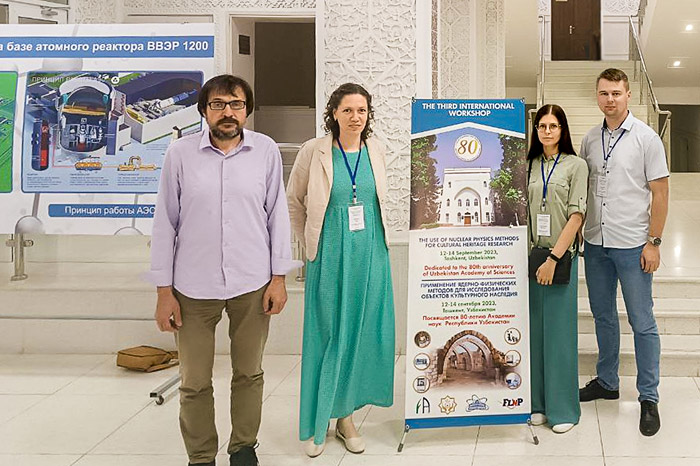
Electronic english version since 2022 |
The newspaper was founded in November 1957
| |
|
Number 37 (4685) |
Science to practice
Researchers in Tashkent
On 12-14 September, the Third International Workshop "Application of nuclear physics methods for the study of cultural heritage objects" was held in Tashkent. This event was organized by the Academy of Sciences and the Institute of Nuclear Physics of the Academy of Sciences of the Republic of Uzbekistan with the support of the Joint Institute for Nuclear Research and the National Research Centre "Kurchatov Institute".
More than 50 scientists from scientific centres of Russia, Uzbekistan, Kazakhstan and Vietnam took part in the Conference. The key objective of the event was to discuss the results already achieved and the prospects for the use of a variety of techniques, including radiography and tomography using neutron and synchrotron beams, neutron and X-ray diffraction, neutron activation analysis, X-ray fluorescence analysis, as well as other techniques such as resonances in nuclear reactions, PIGE, PIXE, RBS, neutron depth profiling.
The Group of Neutron Activation Analysis of FLNP took an active part in the meeting. Head of the Group Andrey Dmitriev presented a report on complementary techniques for analyzing the elemental composition of cultural heritage samples used in the group: neutron activation analysis (NAA), prompt gamma activation analysis (PGAA) and X-ray fluorescence analysis (XRFA). In addition, the members of the Group determine mineral and molecular compositions using Raman and infrared spectroscopy and refine the data obtained using stratigraphy, optical and polarization microscopy, as well as chemical analysis. For field research, the Group widely uses portable devices. The data obtained is interpreted together with relevant specialists. A.Dmitriev spoke about the results of using the digital reconstruction technique aimed at restoring the possible original appearance of wall paintings.

Senior researcher Olga Filippova, in her report at the Conference, focused on a comprehensive investigation of the lost 12th-century paintings of the Church of St. John on Opoki in Veliky Novgorod. In the presented paper, the NAA was successfully applied to determine the elemental composition and to identify the recipes of ancient plaster bases. Using XRFA, polarization microscopy and Raman spectroscopy, the main set of pigments used in painting the cathedral was defined and to determine the characteristics of the painting techniques, an optical investigation of microsections of paint layers and an analysis of the binder using infrared spectroscopy were carried out.
Engineer Natalya Glombotskaya shared the results of her research into the wall paintings and plaster foundations of the Assumption Cathedral in the Moscow Kremlin. The staff members of the Group were lucky enough to work with this unique monument: its procurement documents record the set of pigments used to paint the cathedral. Therefore, art historians and restorers were interested in the issue of verifying the set of pigments, as well as dating the gilding on various fragments of the painting. The search for answers to the tasks posed was impossible without the involvement of XRFA, stratigraphy, polarization microscopy and chemical analysis. As a result of the work carried out, the set of pigments and the structure of the wall paintings were refined. The next step is to compare the resulting set of pigments with the data from the procurement documents. Several options for resolving the issue of dating gilding are also presented.
Senior engineer Valery Lobachev presented the results of an investigation of masonry mortars of the St. George's Cathedral of the Yuriev Monastery in Veliky Novgorod. The main goal of this work is the classification of building materials based on their elemental composition. The NAA was used to determine the elemental composition. Five samples were irradiated at the IREN facility, four of which have precise dates (12th and 19th centuries). As a result of analysis using the IREN facility, data on the mass fractions of 16 elements were obtained for the first time. The samples were also classified according to their main oxides that suggests, the masonry mortar of unknown date probably dates back to the 19th century.
The participation of the Group of the Neutron Activation Analysis in the Conference contributed to the establishment of new contacts, demonstration of capabilities and exchange of experience in the field of application of nuclear physics methods for the research of cultural heritage objects.
Natalya GLOMBOTSKAYA,
Valery LOBACHEV